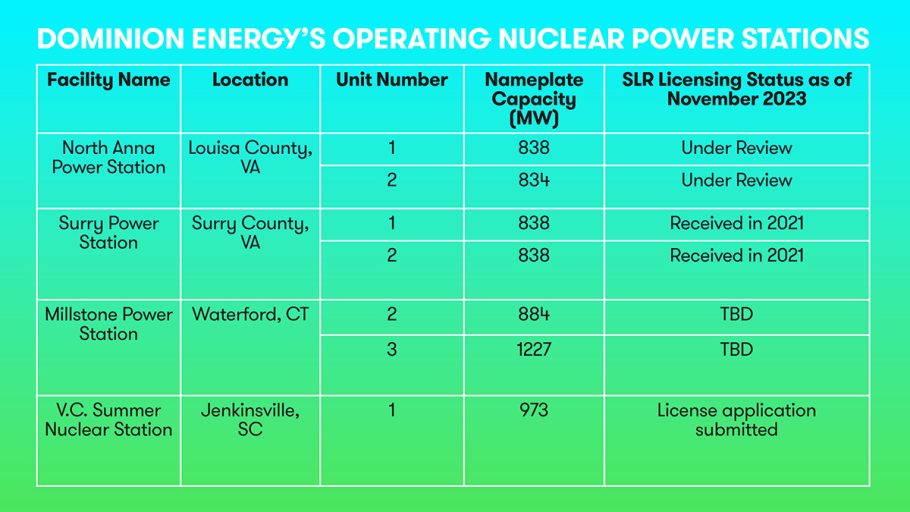Data centers are an economic engine in Virginia, where Dominion Energy calls home. Along with population growth and the ever-increasing number of electric vehicles and equipment, they are the reason why our grid operator, PJM, forecasts annual peak and energy load growth of 5 percent and 7 percent respectively over the next decade in the Dominion Zone. While all signs point to the rising amount of electricity we will need to deliver, our priorities haven’t changed—we aim to provide reliable, affordable, and increasingly clean power to our customers every day.
Dominion Energy was one of the earliest utilities to commit to net-zero carbon emissions by 2050. The question often arises: Does net-zero need nuclear? Numerous national and global studies have concluded that zero-carbon emissions in the electric power industry cannot be accomplished without the world’s existing nuclear facilities and the construction of new nuclear power stations, along with other technologies.
More broadly, to accomplish these clean energy goals, the arc of transformation within our power generation businesses will require a phased approach. This shift will first be accomplished with technologies we know today, such as traditional nuclear, solar, onshore and offshore wind, energy storage (which includes pumped hydro), and importantly, natural gas-fired generation. This initial shift will also need to be accompanied in the future by innovative technologies we are evaluating, such as advanced small modular nuclear reactors (SMRs), clean hydrogen, carbon capture and sequestration, new long-duration storage technologies, and possibly others on the horizon. We will be taking a portfolio approach to this strategy, as we recognize that too much of any one technology has diminishing value to the electric system and our customers.

Standard Nuclear Energy
Nuclear energy is the largest source of clean, carbon-free electricity in the country and operates 24/7/365. For more than 50 years, Dominion Energy has been operating nuclear power stations. We own seven operating nuclear units—Surry Units 1 and 2 and North Anna Units 1 and 2 in Virginia, Millstone Units 2 and 3 in Connecticut, and V.C. Summer Unit 1 in South Carolina. Our seven reactors produce more than 6,400MW, enough to power more than 1.6 million homes. We have a proven track record of providing affordable and clean electricity when needed by our customers, in a safe, reliable manner that also protects the environment. In fact, in the states where these units operate, they produce the vast majority of the zero-carbon electricity for the region. Due to the large amounts of affordable zero-carbon energy produced by these assets, our company sought a Subsequent License Renewal, or “SLR,” from the US Nuclear Regulatory Commission (NRC), for Surry Units 1 and 2, to extend the operating life from 60 to 80 years. In May 2021, we received NRC approval, which currently makes us the only company in the US to hold SLR licenses for commercial nuclear power stations. We are also pursuing SLRs for North Anna Units 1 and 2 and V.C. Summer Unit 1 and anticipate our Millstone nuclear units to follow a similar path in the future, though no decision has been made to do so at this time.

Advanced Nuclear Energy
Our company is also evaluating advanced nuclear technologies to achieve net-zero carbon emissions. SMRs offer an alternative to the larger, traditional nuclear technologies. These technologies are typically in the range of 75MW to 350MW per reactor, which makes them more construction-friendly and financially more manageable than building a conventional large 1,000MW to 1,500MW reactor. All commercial nuclear power stations operating in the United States today utilize what are called light-water reactor configurations, or systems that use water as both the thermal working fluid / coolant and neutron moderator. Several SMR technology vendors, most of which are based in the United States, are in the process of gaining approval for light-water reactor configurations. Other advanced designs use different technologies, some of which are expected to have the unique operating capability of ramping up and down their output within minutes, as compared to several hours for the light-water reactor designs. Given the anticipated dispatchable or load-following capabilities of these SMR designs, they could serve as a carbon-free complement to the large volumes of intermittent renewable generation that we plan to deploy over the next few decades.
Data centers provide an essential service and contribute to the economy in several ways, including creating jobs, generating tax revenues, and attracting other business. Our commitment to serve our customers and to power them while transitioning to cleaner energy sources helps data centers, and all our customers, achieve their carbon goals. SMRs could help maintain electric reliability for our customers and avoid the challenges experienced by other parts of the country in the past few years. Customers are expecting us to get to 100 percent clean energy while also maintaining near perfect reliability and affordability. SMRs could be part of the solution.
Among other benefits, SMRs are expected to be built modularly and the equipment transported more easily, which reduces the site construction risk associated with larger and more traditional new nuclear facilities. Their smaller size, modular components, and passive safety features make it possible to place them in many more locations—on brownfield sites, such as retired fossil-fuel plants, at existing nuclear sites that have operating units, at existing industrial and military sites, and at new greenfield locations closer to where the electric demand is located. Only 50 to 100 acres are needed to deploy these new technologies. The economic development opportunities—new jobs and additional tax revenues—are also significant.

A Multifaceted Approach to Green Energy
The development of new nuclear facilities also requires a clear path, including a predictable licensing process at the federal level. We will also continue to educate communities about nuclear power and the coming SMR opportunities, including the clear message that nuclear power is not only safe and clean, but also a reliable backbone to our state and national economies. If SMR costs are reasonable and we have community support, we believe SMRs have a bright future, but businesses, policymakers, and the public will have roles to play to enable their success. More broadly, our nation’s ability to compete on the world economic stage relies a great deal on our ability to deliver safe, reliable, affordable, and increasingly clean energy. This mission is one that must not fail, and it is important that we all see it that way.
ABOUT THE AUTHOR
Emil Avram is responsible for the growth and development of the regulated utility power generation portfolio within Dominion Energy Virginia as well as other affiliate businesses, including development of nuclear, fossil fuel, renewable energy, and energy storage facilities. He has led the development and construction of over 20 billion USD in energy, gas pipeline, and power generation projects.
He has served on the board of the Center for Innovative Technology (CIT)—which grows and diversifies Virginia’s economy by investing in and accelerating innovation, commercialization, and entrepreneurship—and on the board of HomeAgain—which helps families and individuals experiencing homelessness in the Richmond area secure and maintain a home again.
Avram received his bachelor’s degree in aerospace engineering from Massachusetts Institute of Technology (MIT), his master’s degree in mechanical engineering from Rensselaer Polytechnic Institute, and his MBA from the University of Connecticut. He and his wife, Lisa, live in Goochland County, Virginia and have one son, who is currently attending Virginia Tech.



